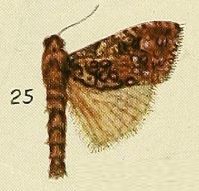
The Lymantriinae are a subfamily of moths of the family Erebidae. The taxon was erected by George Hampson in 1893.

Spilomelinae is a very species-rich subfamily of the lepidopteran family Crambidae, the crambid snout moths. With 4,135 described species in 344 genera worldwide, it is the most speciose group among pyraloids.

Eucereon is a genus of tiger moths in the family Erebidae. The genus was erected by Jacob Hübner in 1819.

The genus Crambus includes around 155 species of moths in the family Crambidae, distributed globally. The adult stages are called crambid snout moths, while the larvae of Crambus and the related genus Herpetogramma are the sod webworms, which can damage grasses.

Lophocampa is a genus of moths in the family Erebidae. The genus was erected by Thaddeus William Harris in 1841. It contains around 75 species.
Mantala is a monotypic moth genus in the subfamily Arctiinae. Its single species, Mantala tineoides, is found on Borneo. Both the genus and the species were first described by Francis Walker in 1862. The habitat consists of lowland and lower montane forests.
Pseudoscaptia is a monotypic moth genus in the family Erebidae erected by George Hampson in 1914. Its only species, Pseudoscaptia rothschildi, was first described by Max Wilhelm Karl Draudt in 1912. It is found in the north-eastern Himalayas, Vietnam, Thailand, as well as on Malacca, Sumatra, Java and Borneo. The habitat consists of lowland forests, including secondary forests.

Pseudosphex is a genus of tiger moths in the family Erebidae. The genus was erected by Jacob Hübner in 1818. These moths are mimics of a variety of Hymenoptera. The prefix pseudo means "false", and Sphex is a genus of wasps.
Siculifer is a monotypic moth genus in the subfamily Arctiinae. Its single species, Siculifer bilineatus, is found in Assam, India. Both the genus and species were first described by George Hampson in 1896.

Agrotera is a genus of snout moths in the subfamily Spilomelinae of the family Crambidae. It is the type genus of the tribe Agroterini and currently comprises 28 species distributed in the Afrotropical, Palearctic, Indomalayan and Australasian realm.

Scirpophaga is a genus of moths of the family Crambidae described by Georg Friedrich Treitschke in 1832. Asian species include significant rice stemborer pests.
Asplenia melanodonta is the only species in the monotypic moth genus Asplenia of the family Noctuidae. The species is found in Africa. Both the genus and the species were first described by George Hampson, the genus in 1916 and the species in 1896.
Haematosticta is a monotypic moth genus of the family Noctuidae. Its only species, Haematosticta sanguiguttata, is found in Sri Lanka. Both the genus and species were first described by George Hampson in 1896.
Stenostygia is a monotypic moth genus of the family Noctuidae. Its only species, Stenostygia nigritula, is found in Sri Lanka. Both the genus and species were first described by George Hampson, the genus in 1910 and the species 14 years earlier in 1896.

Asota kinabaluensis is a species of noctuoid moth in the family Erebidae first described by Walter Rothschild in 1896. It appears to have no close relatives in the genus Asota.

Asura fulguritis is a lichen moth of the family Erebidae, subfamily Arctiinae. The species was first described by George Hampson in 1900. It is found on Bali, Java, Sumatra, Pulo Laut, Borneo and Peninsular Malaysia. The habitat consists of lowland and lower montane forests.

Manoba tesselata is a moth in the family Nolidae. It was described by George Hampson in 1896. It is found in Taiwan, as well as on Borneo, Sumatra, Java, Bali, Seram and the north-eastern Himalayas and in Thailand. The habitat consists of montane forests.

The Metarbelidae are a family of the Cossoidea also called the carpenter or goat moths, and is sometimes treated as a subfamily, Metarbelinae of the Cossidae. No synapomorphies are shared with the Cossidae based on adult morphology. The family Metarbelidae was first described by Embrik Strand in 1909.

Metarbela is a genus of moths in the family Cossidae described by William Jacob Holland in 1893.
Malickyella is a genus of snout moth in the species-rich subfamily Spilomelinae of the family Crambidae. The genus was described in 2010 by the German entomologists Wolfram Mey and Wolfgang Speidel based on material from South-East Asia. The four species of the genus are distributed in the lowland forests of the Indomalayan realm, stretching from the Indian state of Assam to the Philippines.











